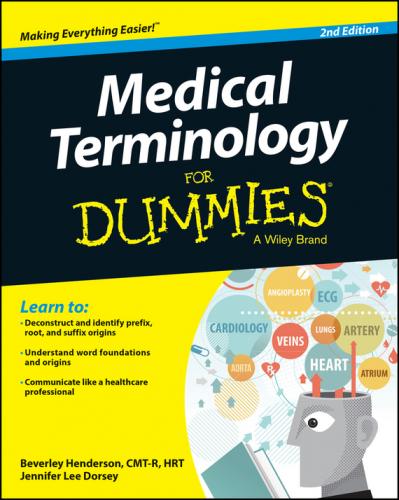Pluralized medical terms would be pretty easy to comprehend and remember if all examples followed the same rules. The fun (fun?) of the English language is that there are several words that do not follow the rules. To see this, all you have to do is look to some basic examples from everyday conversation.
The standard rule is to add an s to make a noun plural, so one cat and one dog become two or more cats and dogs. Simple. But how about one woman, one man, and one child? This pluralization becomes two or more women, men, and children. So much for simply adding the s. Women, men, and children are irregular plurals.
For the most part, terms of Latin or Greek origin do not follow English rules when it comes to pluralizing. However, luckily for you, it is becoming more and more acceptable for medical terms to be pluralized by the English method. But first, take a quick look at three common kinds of common medical terminology: acronyms, eponyms, and homonyms.
Acronyms
An acronym is a word (or abbreviation) formed by the first letters or syllables of other words. Most acronyms are expressed in uppercase letters, but not always. For example, you might be familiar with the words scuba and laser. These terms are so well known that they have become acceptable as words in their own right. Scuba began life as an acronym for self-contained underwater breathing apparatus. Laser was an acronym for light amplification by stimulated emission of radiation. These two humble acronyms went on to greater glory as bona fide words.
There are, to put it mildly, many acronyms in medical terminology, some of which are common, some not so common. It is important to know the context in which they are used, because many are identical or sound similar, but have quite different meanings. Here are some common medical acronyms.
✔ AMA: American Medical Association
✔ AMA: Against medical advice
✔ CAT: Computerized axial tomography (scan)
✔ CAT: Children’s apperception test
✔ COPD: Chronic obstructive pulmonary disease
✔ COPE: Chronic obstructive pulmonary emphysema
✔ ECT: Electroconvulsive therapy (shock therapy)
✔ ECT: Enteric-coated tablet
✔ ECT: Euglobulin clot test
✔ MRI: Magnetic resonance imaging
✔ MRI: Medical Research Institute
✔ MRI: Medical records information
Next on the tour of plural forms is the antonym, proving once and for all that opposites do attract. An antonym is a word that means the opposite of another word. Examples would be right/wrong, right/left, up/down, and front/back. With reference to medical terms, some prefixes can be paired as opposites. Table 4-1 lists some of the most popular.
Table 4-1 Medical Antonyms
Eponyms
Eponyms are an unusual and interesting facet of the plural world. An eponym is a person, place, or thing from which a person, place, or thing gets (or is reputed to get) its name. For example, Romulus is the eponym of Rome. It can also refer to a person whose name is a synonym for something (from the Greek eponymos: epi [to] + onyma [name]). In the medical field, a disease, sign, operation, surgical instrument, syndrome, or test is often named after a certain physician, surgeon, scientist, or researcher.
Here are some of the most popular medical eponyms:
✔ Apgar score: Named after Virginia Apgar, American anesthesiologist (1909–1974). A numbering expressing the condition of a newborn infant at 1 minute of age and again at 5 minutes.
✔ Alzheimer’s disease: Named for Alois Alzheimer, a German neurologist (1864–1915). A progressive degenerative disease of the brain.
✔ Cushing’s syndrome: Named for Harvey Williams Cushing, American surgeon (1869–1939). A complex of symptoms caused by hyperactivity of the adrenal cortex.
✔ Down syndrome: Named after John Haydon Down, English physician (1828–1896). A chromosomal disorder, also called trisomy 21, formerly called mongolism.
✔ Gleason grade: Named for Donald Gleason, American pathologist (1920–2008). A rating of prostate cancer assigning scores of 1–5 for degrees of primary and secondary growth.
✔ Hodgkin’s disease: A form of malignant lymphoma. Named for Thomas Hodgkin, an English physician (1798–1866).
✔ Homans’ sign: Named for John Homans, American surgeon (1877–1954). Pain on dorsiflexion of the foot; a sign of thrombosis of deep veins of the calf.
✔ Ligament of Treitz: Located in the intestinal tract. Named after Wenzel Treitz, a Czech physician (1819–1872).
✔ Lyme disease: A multisystemic disorder transmitted by ticks. Named after a place, Old Lyme, Connecticut, where the disease was first reported in 1975.
✔ Peyronie’s disease: Named for Francois de la Peyronie, a French surgeon (1678–1747). It means a deformity or curvature of the penis caused by fibrous tissue within the tunica albuginea. When distortion of the penis is severe it causes erectile dysfunction or severe pain during intercourse.
✔ Parkinson’s disease: Named for James Parkinson, English physician (1755–1824). A group of neurological disorders including tremors and muscular rigidity.
As you can see, most of those famous people are no longer with us. So you had a much better chance of having something named after you if you were born a hundred years ago.
Конец ознакомительного фрагмента.
Текст предоставлен ООО «ЛитРес».
Прочитайте эту книгу целиком, купив полную легальную версию на ЛитРес.
Безопасно оплатить книгу можно банковской картой Visa, MasterCard, Maestro, со счета
